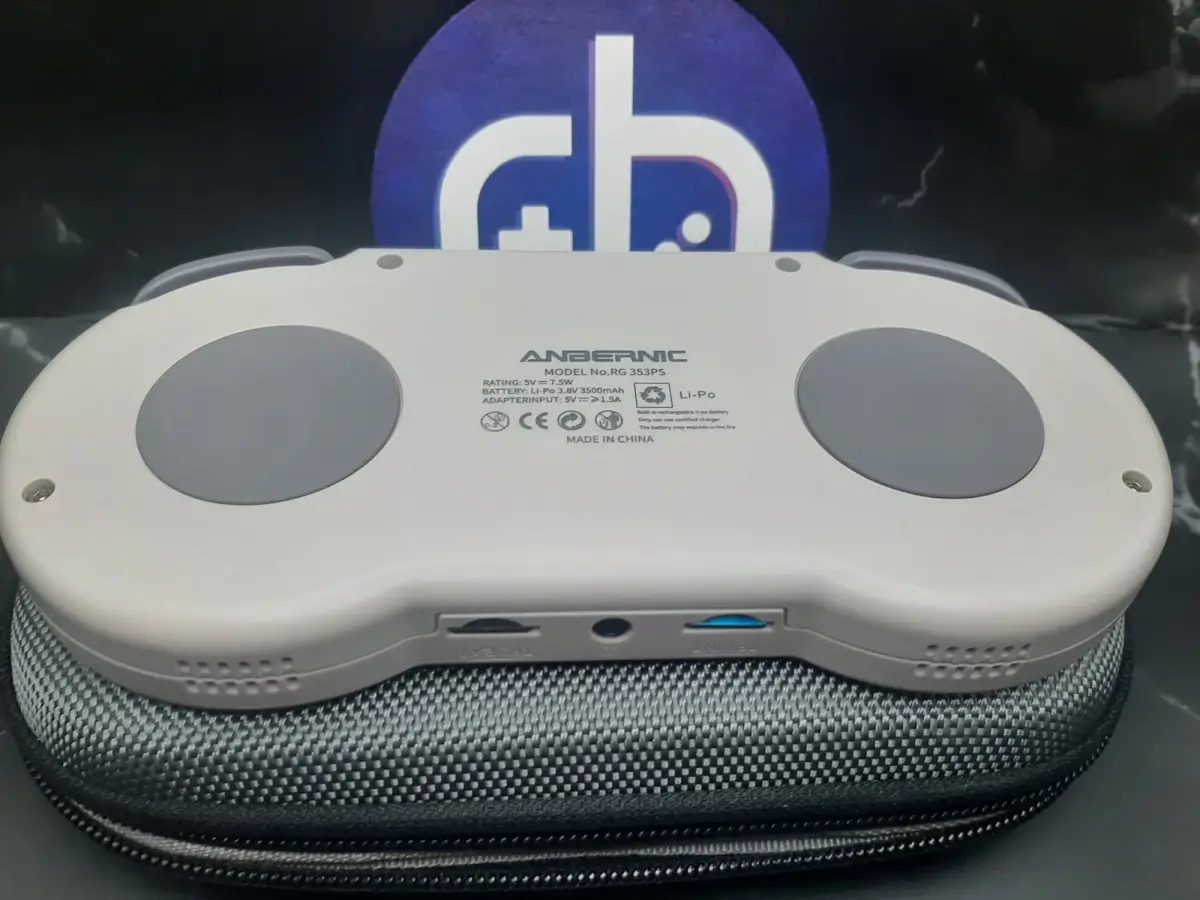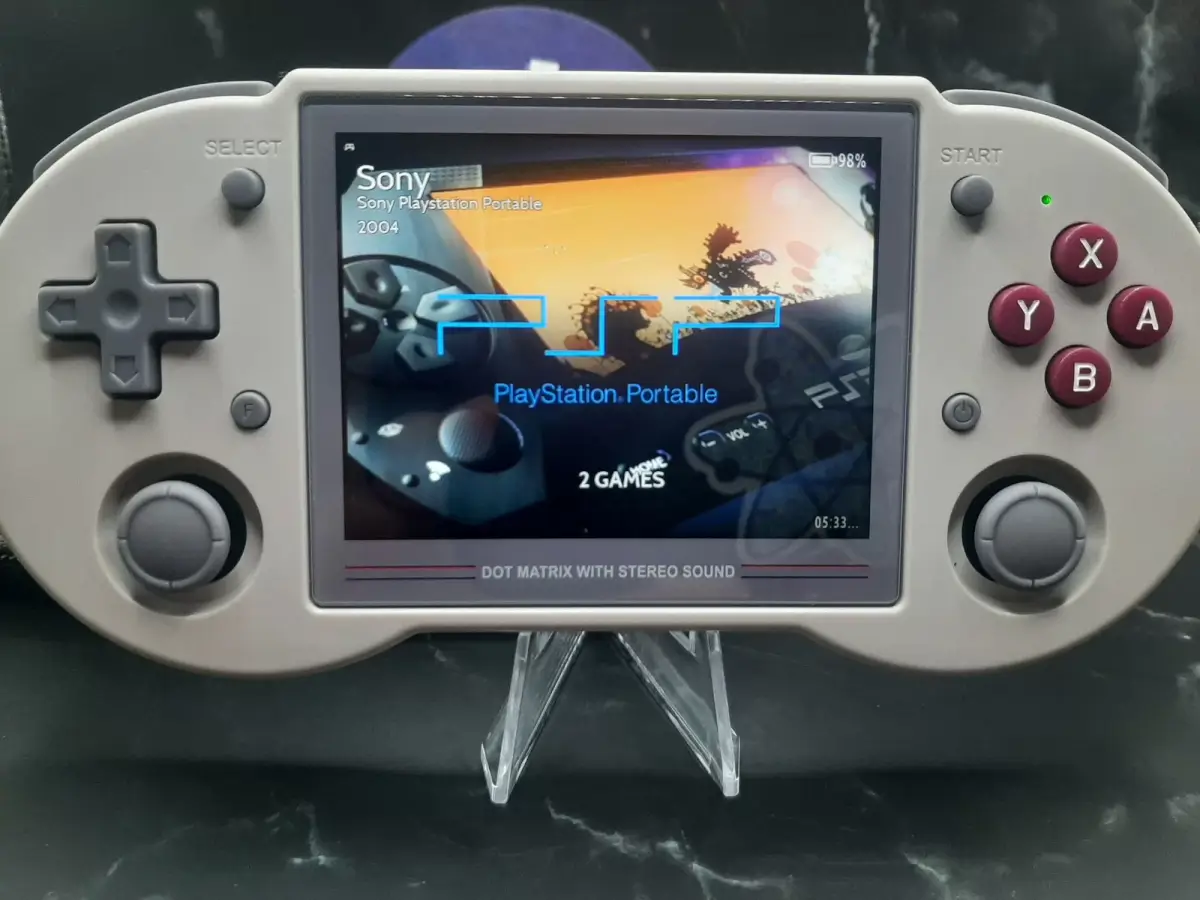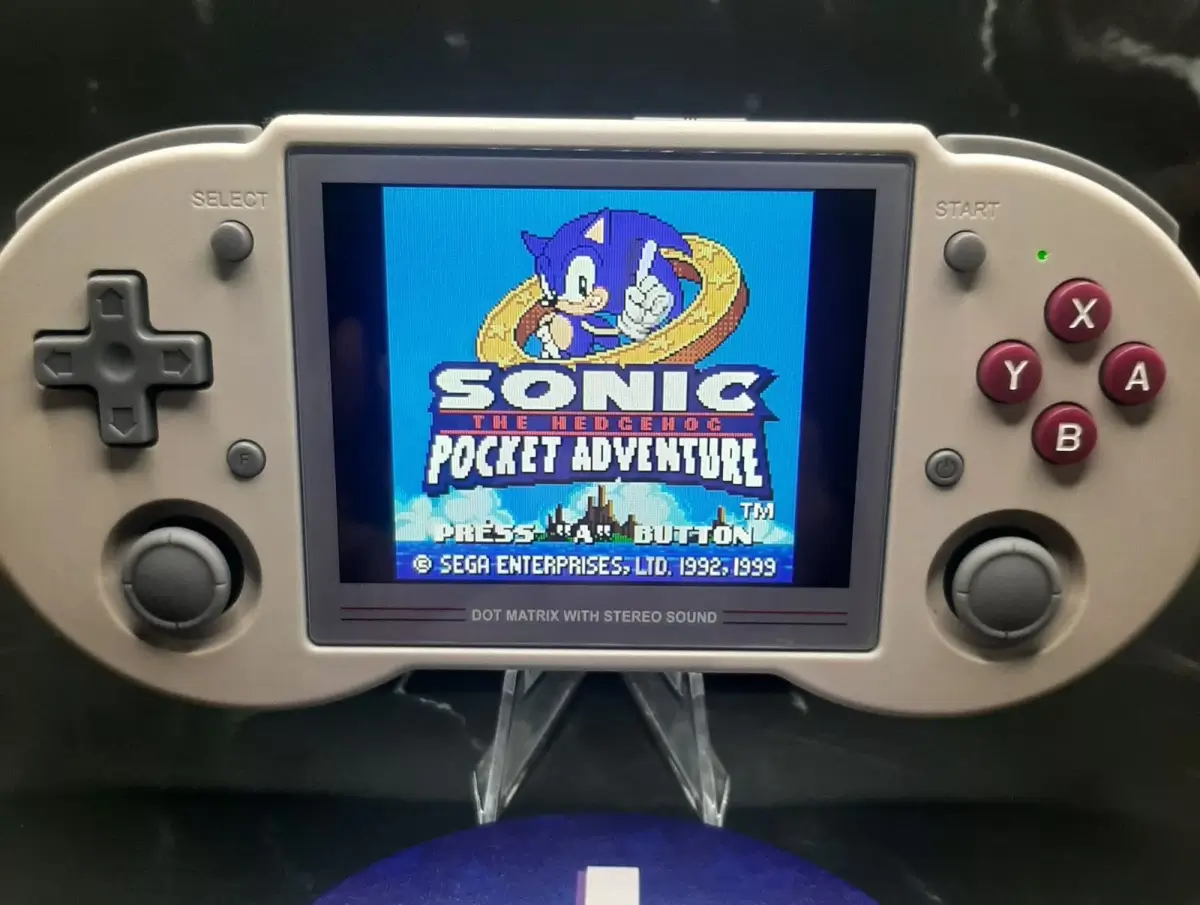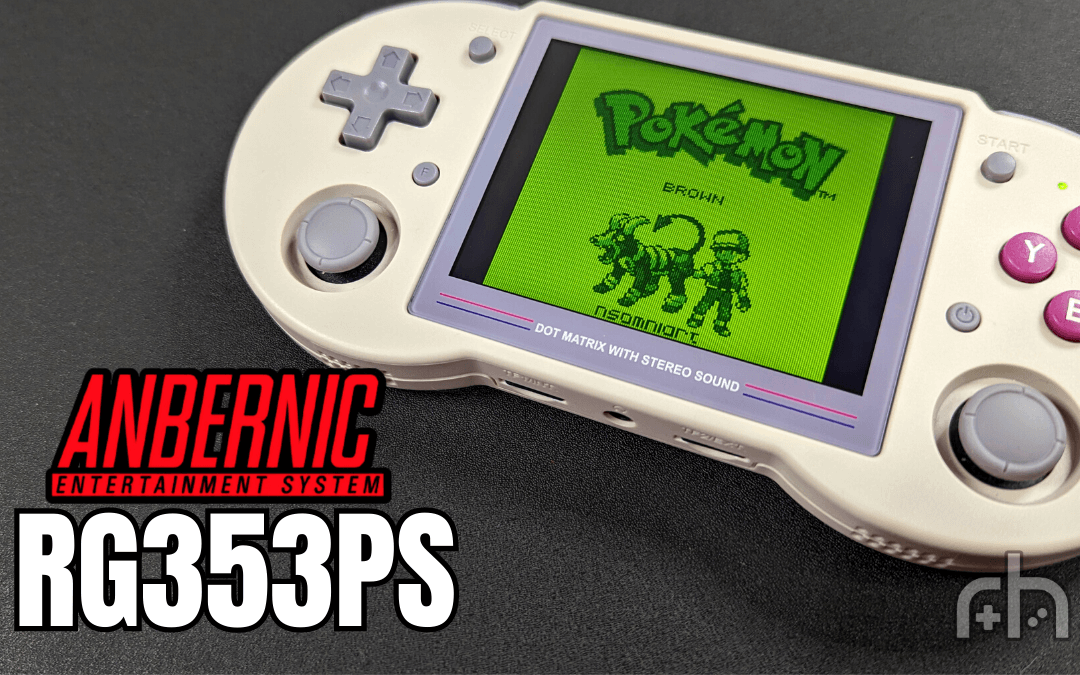What do you get when you take an existing handheld and remove Android from it, add new color schemes, and release it again? Well yes, a lesser device is technically correct, but also you get the newest release from the Anbernic 353 line: the 353PS. It is incredibly similar to the 353P with only a few tweaks that may be considered minor or major depending on your preferences. So in a way, this handheld is both new while also familiar to the community as a whole. It retains the signature SNES controller shape, the typical Anbernic buttons and layout, and the Linux side of the OS options from its predecessor, while sporting some new colorways and…well yeah that’s about it for additions. The screen is the same (minus the touch factor), the shell is the same, and the speakers are identical. So you may be asking yourself what the point was of the company making this particular model of this particular game playing machine, and that really is a fair question. But for the sake of separating the 353PS from its more advanced twin I am going to look at this as a fresh device rather than a recycled one. For those who have not researched the 353P or any other 353 device for that matter, a lot of this information will be new, and for the rest of you, consider it a refresher. So join me as we rediscover for the first time the Anbernic 353PS!
Hardware
Right out of the gate we are getting physical, baby; physical aspects of the 353PS that is. The shell design echoes that of an SNES controller with its rounded sides paired with the signature Nintendo-style button layout that we all know so well. I have to say I am a sucker for this design. The comfort it provides mixed with the nostalgia I feel when I see it creates a powerful potion that I am powerless to resist. That’s without even noting the fact that the color schemes available are prime-time! There are clear and transparent purple each with multicolor face buttons, and a stellar DMG scheme complete with a spot-on matching bezel. The three choices are each great and add to the sexy factor of this device. The button placements are also very well thought out, including stacked shoulder buttons which is rare for a product made by Anbernic. The four face buttons reside on the right side of the screen and above the right analog stick, while the usual Anbernic directional pad sits to the left above another stick.

There are another four buttons on the face just outside the screen bezel: Start and Select up toward the top, while a function button and the Power button reside a bit lower, with Power being on the right. The sticks are Switch-sized and styled and are clickable for those L3/R3 inputs. Along the bottom edge houses a centered headphone jack and two SD card slots, a common layout for the company as they seem to absolutely adore these dual-card setups. The underside of each rounded section holds a stereo speaker making them downward-firing and actually pretty solid. Atop the handheld we find a USB-C OTG port, Reset button, mini-HDMI ports for display out, a volume rocker, and of course a USB-C DC jack. The top sections of the rounded sides of course hold those stacked shoulder buttons I mentioned before. Backside-wise all we see are some screws, company branding, and their signature rubber grips that actually feel quite nice if you rub them while playing. I mentioned but glazed over what is front-and-center on the 353PS and that is of course the screen. The screen? Yes, the screen! Fear not, we’ve not forgotten thee, screen.
The Screen
The biggest thing separating the aesthetic of the 353PS from that of the classic SNES controller is the 3.5 inch IPS screen smack dab in the center of it. It’s OCA laminated and has a resolution of 640×480. Also I suppose the viewing angles are great for all you people who play with their handhelds at a 45 degree angle for some reason. I have noticed no tearing, no bright spots, no imperfections or dead pixels on mine, and the brightness reaches low/high levels that provide a good range. At full brightness it is playable in the sunshine, and at its lowest, it is easy on the eyes in the dark. The aspect ratio of 4:3 creates an amazing environment in which to play a ton of older systems like the Genesis and PS1. Of course this means that the PSP games that it can play may not look the best or fill the screen, but since there are very few systems playable that do not use 4:3, I think the screen is a great fit for the 353PS. My overall feelings toward the screen can be summed up in two words: very acceptable.
The Buttons
If you are actually playing on one of these devices that means you will be pushin’ all them buttons baby. So of course it makes sense to be curious about that experience. Well, I have said it before and I will just go ahead and say it again: Anbernic buttons are excellent. And because they rarely change them from device to device, the quality is consistent. The 353PS is no exception in this regard. The face buttons are the perfect mix of stiff and mushy, the dpad is not clicky (meaning it’s the CORRECT way to do a dpad [Editor’s note: You’re wrong]), and the shoulder buttons are a pleasure to use thanks to the layout and the rounded edges of the handheld. I will say that the dpad was a bit finicky on my unit, registering some false diagonals and making my game testing a bit troublesome at times. The sticks are also a bit low but the reach from them to the triggers is not overly difficult or uncomfortable, so they are serviceable. Other than that the buttons are of superb usability and because of this, the comfort and overall playable nature of the 353PS are each top notch.
The Internals

Heading under the hood we find ourselves in very familiar territory thanks to the RK3566 chip that resides there. The uses, capabilities, and limits of this chip are more than well documented, they are cemented. As such, I will not be going over each and every aspect of the chip, but rather focusing on the other fun things inside our 90’s controller doppelganger, starting with wireless connectivity. That’s right, both Bluetooth and Wi-Fi make an appearance, allowing for things like scraping, retro-achievements, and the use of Bluetooth headphones. That added functionality is a welcome dimension with this device as it keeps it up to date easily and creates a pleasing environment complete with box art and a record of achievements.
So the visual side of things is nice, but what about the audio? Those two downward facing speakers I mentioned before are quite acceptable, but nothing special. They do not seem to get washed out or lose fidelity easily, but I feel like they do not get very loud. Basically, they do their job, just not in an exceptional or even notable way. Accompanying the 3566 chip is 1GB of DDR4 RAM, which is enough for this particular device. As for storage, well for those who do not know, the two SD card setup allows for an OS to be loaded in one, and storage for games and whatnot in the other. It can be nice, but also seems unnecessary to me more often than not. A 3500mAh Li-po battery provides the power for the whole machine, allowing for an estimated 6 hours of use on a single charge. Personally, I found this to be closer to about 4.5-5 hours depending on the systems I was playing. I do however keep the screen brightness at around 60%, so glean from that what you will. I never felt like I was tethered to a wall, but I would not put this battery in some top-tier of all batteries. Much like the speakers, it does its job and is by no means a let-down. The hardware on the 353PS is the reason to purchase it if you choose to do so. The comfort and quality of the shell and buttons are certain to please. Plus if you are an SNES fan, it will cheer you up just to look at the dang thing!
Software
I am sure by now you may have been able to guess what operating system this particular handheld runs on…but in case you haven’t, I’m going to go ahead and tell you: it’s Linux. Unlike the 353P, dual booting with Android is unfortunately not an option. I won’t lie, I find this to be a BIG downside; not only because I actually prefer Android on a device with this amount of power, but also dual booting provides such a nice set of options. However, the focus should be on what the OS CAN do, right? The upside to Linux for most people is the simplicity of the setup process, and it applies very much to this case.

The device ships with a very usable Linux distribution that is basically ready to go right out of the box. It has the systems exhibited in a very simple but appealing way, it is easy to navigate, and I think it would be a great first experience for folks that are new to the emulation/retro handheld scene. Pressing Start or Select will bring up two different menus, each with plenty of options for changing settings and shutting down or restarting the system. Here you will find things like network settings, menu appearance changes, brightness adjustment, and game collection settings. The interface is straightforward and fairly easy to understand and includes more options than most people probably even want! That’s the beauty of Linux when it comes to this device: minimal setup, maximum usability. A sleep function kicks in when the Power button is pressed while the system is on, and as far as I can tell the battery will last a good long while in this state, and getting right back into your game afterwards is quick. You can use the settings menu to change Retroarch settings, change emulators for particular systems, and scrape box art for your game collection. For the most part, if you wish to change something about the way the device is set up, you can.
While I praised the OS quite a bit, I also have to say it is…underwhelming to me. I think it may be the fact that other devices that compete with the 353PS run Android and I simply prefer that. But, I also see how handheld veterans may find this OS a bit boring. Sure it does many things well, but there are many limitations such as game streaming being limited to Moonlight, no native Android apps/games, and lower performance when it comes to N64 games. The lack of another OS option has left me wanting more out of the device, and the fact that the 353P provides that leaves me wondering exactly why someone would choose the PS instead, even with the difference in price. I like the 353PS OS, but I certainly do not love it.
Game Testing

Well, well, well, fancy seeing you here. I knew you wouldn’t be able to resist my game testing section. The ceiling for playability on the RG353PS is around the PSP range, with only a portion of those games being playable. N64 is in the same situation, same goes to Dreamcast. I wish I could say those systems all run perfectly, but alas, I cannot.
The first system I tested was naturally the SNES. I fired up some YS III and immediately thought “dang, this looks good on here.” It ran perfectly as well which was a very welcome sight on something that looks so much like the classic controller for the console. I did not spend a lot of time any systems below the SNES, as this device will have no trouble with them at all. Moving up the ladder I next tested some PlayStation games, mainly Marvel Super Heroes. Besides remembering that I suck at fighting games, I also realized just how nice and smooth it ran, and how comfortable it was to play. I stuck with it for three fights more than I expected to just because the experience was so nice! Great PS1 device, I must say. Jumping up another notch I threw on a Dreamcast game, MSR. It played fine and sounded pretty good as well. The controls were responsive; it looked pretty on the screen. I did notice that the left control stick was not calibrated very well while I played SA2 and in fact it was very sensitive. It made the DC experience a little bit underwhelming. Ok, onto the big time. PSP is the system I was most curious about running on the 353PS, and I will say, it does a pretty solid job of performing. I tried this God of War: Chains of Olympus game that all the kids talk about, and found that it did run decently but encountered a fair amount of stuttering and slowdown. The 16:9 game still looked alright on the somewhat small screen despite the difference in aspect ratios and letterboxing. Grand Theft Auto: Vice City Stories ran quite well indeed, though when trying to up the resolution to 2x, it became a bit less stable and fluid; still playable though for sure. I have to say, I was expecting a bit less bang-for-my-buck as far as PSP play was concerned, but it pleasantly surprised me. The last system I tested was of course N64 and I jumped straight to Conker’s, with it being a tough game to run, I figured I might as well push it to the limit straight away. Well…unfortunately I had a somewhat poor experience. It did surprisingly run somewhat nicely, but there were almost constant graphical glitches, some of them whole-screen scrambles. I suspect this is mainly the fault of the emulator rather than the hardware itself, but nonetheless, disappointing for a device this price, in the year 2023 at least. I’d say if you are concerned with playing the full N64 library at full speed this is not the handheld for you. However, most games should be able to run at an acceptable rate.
| Fully Playable |
|---|
| Atari 2600, Atari 5600, Atari 7800 |
| Nintendo Entertainment System |
| Super Nintendo Entertainment System |
| Nintendo Game Boy |
| Nintendo Game Boy Color |
| Nintendo Game Boy Advance |
| Nintendo Virtual Boy |
| Nintendo DS |
| Sega Master System |
| Sega Genesis / Mega Drive |
| Sega 32X |
| Sega CD |
| Neo Geo Pocket |
| Neo Geo Pocket Color |
| Sony PlayStation |
| Sega Saturn |
| Mostly Playable |
| Nintendo 64 |
| Sega Dreamcast |
| Sony PlayStation Portable |
| Out of Reach |
| Sony PlayStation 2 |
| Nintendo GameCube |
| Nintendo 3DS |
Where to Buy
Anbernic Official
AliExpress
Amazon
Average Price
$100-125
Delicious:
- SNES controller-style shape: HARD yes!
- Stacked triggers are best, add to overall comfort which is top-notch.
- Typical Anbernic button quality.
- Sweet color schemes.
- Good battery life.
Suspicious:
- Linux only which limits possibilities.
- Less power than I would like for the price.
- Overall downgrade from the RG353M/P/V devices.
- Not very pocketable.
Final Thoughts:
- I have gone back and forth in my head about this device, as I did with its older twin. There are aspects of it that I absolutely love, and yet there seem to be just as many things that I dislike. It is hands down the most comfortable handheld that I have; the shape sets off wicked nostalgia. On the flip side, the OS leaves a lot to be desired and as such the performance suffers. It suffers a bit too much, actually. Anbernic always has somewhat high prices compared to their competitors, and in this case I feel like it’s quite detrimental to the device. When there are much more powerful options around like the Retroid Pocket 3+ for just a little more money, it is hard to recommend the 353PS. It sort of feels like a gateway device to me: you buy it and use it, possibly even love it, but then find something a bit more capable for a good price and leave this one on the shelf or sell it off. So in that regard I think it is worth picking up if you really like the style and know the capabilities, or if you are a beginner that wants a high quality entry into the retro handheld hobby. Just do not expect it to be a “one-and-only” type of toy. Unless you are happy paying a premium price for some PSP and N64, and I know some people are, then maybe this is one to skip; maybe look into the 353P. Do your research and make the choice. Give the RG353PS a shot? Or keep your cash for something stronger? Red pill, or b… you get it.
(This review has been written and provided by Rocketman824)
